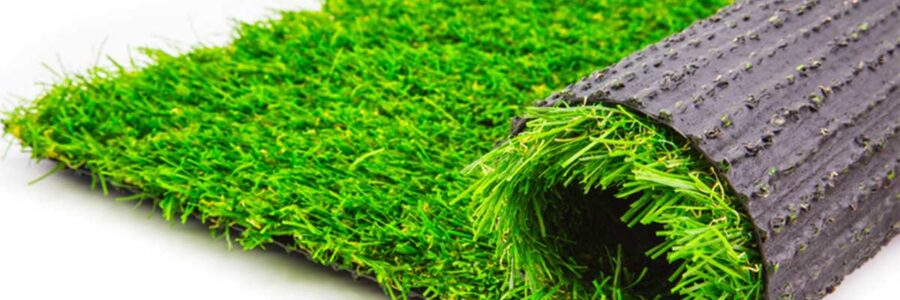Artificial turf, commonly known as AstroTurf, has raised concerns due to its potential health hazards and environmental impacts. Let’s delve deeper into this topic and explore the various aspects of AstroTurf.
Composition of AstroTurf:
AstroTurf consists of different layers, including a backing material, blades of grass, and infill. The backing material is often made from polyester tire cords, which can contain chemicals like polyvinyl chloride (PVC).[1] PVC production involves phthalates known to cause health issues, including hormone disruption.[2]
The blades of grass in AstroTurf are typically made from polyethylene or nylon. Additionally, these blades undergo treatment with UV inhibitors, color stabilizers, and flame retardants to ensure durability. However, over time, these additives can leach into the environment, potentially contaminating soil and water.[3]
The infill of AstroTurf is a mixture of sand and crumb rubber from recycled tires. However, these rubber crumbs can contain hazardous substances such as polycyclic aromatic hydrocarbons (PAHs), volatile organic compounds (VOCs), and heavy metals like lead and zinc.[4] These chemicals have been associated with various health risks, including skin and eye irritation and cancer.
Environmental Impact:
The production of AstroTurf consumes a significant amount of energy and relies on non-renewable resources, mainly petroleum products. This process contributes to greenhouse gas emissions, exacerbating climate change.[6] When AstroTurf reaches the end of its lifespan, it is often discarded in landfills, where it can take hundreds or thousands of years to degrade.
During this time, the leaching of chemicals from AstroTurf can adversely affect soil and groundwater quality.[8] Additionally, AstroTurf can contribute to the urban heat island effect, raising local temperatures and causing heat-related illnesses. It also hampers rainwater absorption, leading to runoff that carries chemicals into waterways, posing risks to aquatic life.[8]
Health Hazards:
There are concerns about the potential health risks associated with AstroTurf, especially for children and athletes who spend significant time on these artificial surfaces. The rubber crumbs in the infill can stick to the skin, be inhaled, or even swallowed. In addition, these crumbs contain chemicals, including known carcinogens.[10]
Some studies have suggested a link between exposure to crumb rubber and an increased risk of cancer, particularly lymphoma and leukemia.[11] Other health concerns include heat stress from high surface temperatures, skin abrasions, and allergic reactions.[10]
Safer Alternatives:
Considering the concerns associated with AstroTurf, exploring safer alternatives is crucial. For example, natural grass, although requiring more maintenance, offers benefits such as carbon storage, temperature regulation, and support for local wildlife.[8]
Another option is using AstroTurf with organic or plant-based infill, such as coconut fiber or cork, which reduces exposure to harmful chemicals [8]. Finally, combining natural grass and synthetic fibers, hybrid grass systems balance durability and natural benefits.[8]
To minimize potential risks, if AstroTurf is the only option, stakeholders can take certain steps. For example, regular surface cleaning to reduce dust and chemical residue, spraying water to lower the temperature and prevent airborne rubber particles, and promoting proper hygiene after use can all help mitigate exposure to harmful substances.[8]
Conclusion
AstroTurf raises concerns due to potentially toxic components and negative environmental impacts. Research is needed to understand the risks associated with AstroTurf and develop more sustainable options. Moreover, striking a balance between convenience and responsibility towards our health and the environment is key.
References:
- AstroTurf. (n.d.). The History of Astroturf Corporation. Retrieved from astroturf.com/the-history-of-astroturf-corporation/
- Wang, Y., & Qian, H. (2021). Phthalates and Their Impacts on Human Health. Healthcare (Basel, Switzerland), 9(5), 603. doi:10.3390/healthcare9050603
- Campanale, C., et al. (2020). A Detailed Review Study on Potential Effects of Microplastics and Additives of Concern on Human Health. International Journal of Environmental Research and Public Health, 17(4), 1212. doi:10.3390/ijerph17041212
- Celeiro, M., et al. (2021). Evaluation of Chemicals of Environmental Concern in Crumb Rubber and Water Leachates from Several Types of Synthetic Turf Football Pitches. Chemosphere, 270, 128610. doi:10.1016/j.chemosphere.2020.128610
- National Geographic. Nonrenewable Resources. Retrieved from education.nationalgeographic.org/resource/nonrenewable-resources/
- EPA. Sources of Greenhouse Gas Emissions. Retrieved fromwww.epa.gov/ghgemissions/sources-greenhouse-gas-emissions
- Cheng, H., et al. (2014). Environmental and Health Impacts of Artificial Turf: A Review. Environmental Science & Technology, 48(4), 2114–2129. doi:10.1021/es4044193
- City of Peoria. Artificial Turf. Retrieved fromwww.peoriaaz.gov/government/departments/water-services/sustainability-water-conservation/conservation/artificial-turf
- National Center for Health Research. Children and Athletes at Play on Toxic Turf and Playgrounds. Retrieved fromwww.center4research.org/children-athletes-play-toxic-turf-playgrounds/
- Bleyer, A. (2017). Synthetic Turf Fields, Crumb Rubber, and Alleged Cancer Risk. Sports Medicine, 47(12), 2437-2441. doi:10.1007/s40279-017-0735-x


